#vijayanagara
Explore tagged Tumblr posts
Text
Top 10 new to me games of 2024!
Ok, so I already made a top 10 of my most played games of 2024. Now let’s go on with my top 10 of new to me games I played last year. And let’s see if my most played games are also my favorites. But maybe I’ll begin with some statistics: Last year I played 98 games out of which 68 were new to me. So more than one new game each week! Crazy if you think about it. My H-Index lies at 7. So 7 games…
#bayonets and tomahawks#boardgame#boardgames#brettspiel#brettspiele#crisis1941#hearts and minds#landandfreedom#pax porfiriana#plantagenet#prelude to revolution#triomphe à marengo#vijayanagara#Wargame#wargames#wargaming#weimar
3 notes
·
View notes
Text




anyway I heart medieval and early modern vijayanagar 🙏shoutout to the nayaka and I heart public works and diverse society
#art history#medieval art#medieval history#south Asian history#indian history#nayaka dynasties#nayaka#vijayanagar#vijayanagara history#deccan sultanates#deccan plateau
5 notes
·
View notes
Video
youtube
Ekasila Nagaram: Rama Idol Sculpted in Treta Yuga | హనుమ లేని రాముడా?
#youtube#Ekasila Nagaram#Rama Idol Sculpted in Treta Yuga#హనుమ లేని రాముడా#Kodanda Rama Swamy Temple#Kodandarama Temple#Vontimitta#cholakings#Agnikulas#Vijayanagara kings#sita rama#Sri Rama Navami#Bammera Potana#ramayana#bhagavatham#monuments of national importance#16th century#dravidian architecture#ekasila#tretayuga#treta yuga#famous temples#temple tour#Temple Darshanam#temples of india#yoga rama#rayalaseema#voice of maheedhar#mplanetleaf
0 notes
Text

India's $725 Billion Drain: Unveiling the Shocking Truth Behind Economic Meltdown | Empire Diaries
#Vijayanagar empire#history of vijayanagar empire#vijayanagar empire history#hampi#karnataka#vijayanagara empire#the fall of vijayanagar empire#ancient india economy#indian economy in ancient time#pre independece indian economy#colonial era economy#indian economic past#economy#economic downfall#vijaynagara empire#Hampi#economics#India#poverty#politics#governance#economic development#social issues#Empire Diaries On Road#trade deficit of india#economic disaster
0 notes
Text
Are you preparing for the class 12 history board exam and competitive exam? An imperial capital Vijayanagara class 12 history chapter 7 is crucial for your exam. Memorysclub educators provide an imperial capital Vijayanagara question answer with notes. Which is essential for your upcoming exam.

0 notes
Text
Telugu, using “తాను/తను” (tānu/tanu), a gender-neutral pronoun in literature and music is my Vijayanagara empire !
#telugu#language#aesthetic#telugu quotes#linguistics#telugulanguage#literature#linguistic phenomenon
44 notes
·
View notes
Text

Kodanda Ramaswamy Temple, Vontimitta, India: Kodandarama Temple is a Hindu temple dedicated to the god Rama, located in Vontimitta town in Vontimitta Mandalam of Kadapa District in the Indian state of Andhra. The temple, an example of Vijayanagara architectural style, is dated to the 16th century. It is stated to be the largest temple in the region. Wikipedia
46 notes
·
View notes
Text
2024 Book Review #13 – Victory City by Salman Rushdie
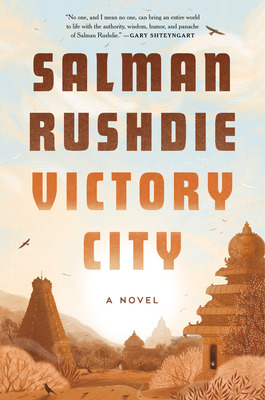
One of my goals for the year is to read more proper literature (here defined as fiction I can mention reading to my mother without getting judged for it). I’ve never read anything of Rushdie’s before, but I did remember his name in the news recently due to the whole attempted-murder thing and, happily, my library actually had a copy of his newest work. So, picked this up and read it sight unseen!
The book follows one Pampa Kampana – a nine-year-old girl who, in the 14th century, witnesses her city destroyed, and her mother burning herself alive. She is then inhabited and blessed by a goddess, blessed/cursed with a lifespan measured in centuries and the destiny of raising an empire up and seeing it fall before she dies.
The narrative is framed as a modern adaptation/summary of the epic poem recounting her life Pampa completes before finally dying, finally discovered and translated after being forgotten in the ruins of te imperial capital for centuries. The story is largely a story of this miraculous, semi-utopian empire, as told Pampa’s eyes (and with a lengthy digression during the years she spends in exile).
This is a story that exists somewhere in the muddy middle ground between historical low fantasy and magical realism – it’s in some sense an alternate history of the Vijayanagara Empire, and replete with historical trivia and references, but is quite clear from the outset that accuracy is not really something the book cares about. Instead, the book’s Vijayanagara – always written as Bisnaga, as it was translated by a historical Portuguese chronicler whose also a minor character in the story, to prevent confusion – is basically allegory and morality tale with a light coating of history for flavour.
Not that I can really begrudge Rushdie for his strident politics (as far as I can tell I basically agree with him on all of it), but this really does feel like one of those old fantastical utopias, or a political treatise that gets past the censors by pretending to be the history of a foreign country, more than it does a novel. Which could definitely work! But in this case really didn’t, at least for me. There’s enough time spent on characterization and character drama to eat up pages, but not enough for it to ever feel like they’re people and not just marionettes acting out a show. I suppose the best way to get across the reading experience is that I was reading a proper 500 page history book at the same time as I read this, and this felt like the bigger slog by far.
Though part of that might just be disappointed expectations that I really had no right to have in the first place? As I said, I had Rushdie slotted in my head as a literary author, but really I don’t know nearly enough about him or his work to justify that. So I came to this expecting to be at least a bit wowed and bedazzled by the artistry and beautiful prose on display – and like, eh? Not bad, to be sure, the narrative voice and the framing device are both fun and fairly well done. But having read it there’s really not a single passage or sequence I can say has stuck with me.
The comparison that comes to mind is Kalpa Imperial by Angélica Gorodischer, which is also a book-length epic history of a fantastical empire that never was which laughs at all conventional wisdom about pacing, characterization and plot (and which also has been shelved as magical realism for what are basically reasons genre snobbery imo). It’s been a few years since I read it, but from what I recall that agreed with me far more. Maybe just because it abandoned the conceit of a single protagonist and family melodrama entirely, or maybe because it had a bit more subtle in its social commentary (or maybe it was just better written on a sentence-to-sentence level).
Though I should say, there’s every possibility I’m being a bit harsher on this than it entirely deserves – it’s an entirely competent book! The politics are blatant but like a) they’re politics I agree with and b) they’re nowhere near the most blatant or forced-feeling inclusion of progressive politics in fiction I’ve seen recently. However, this is also a piece of writing that’s among other things very clearly and directly about how important and sublime and world-changing the art of writing is. Which is like a movie about making it in showbuisness, or a musical about how great singing is. Automatic deduction of a full letter grade.
33 notes
·
View notes
Text
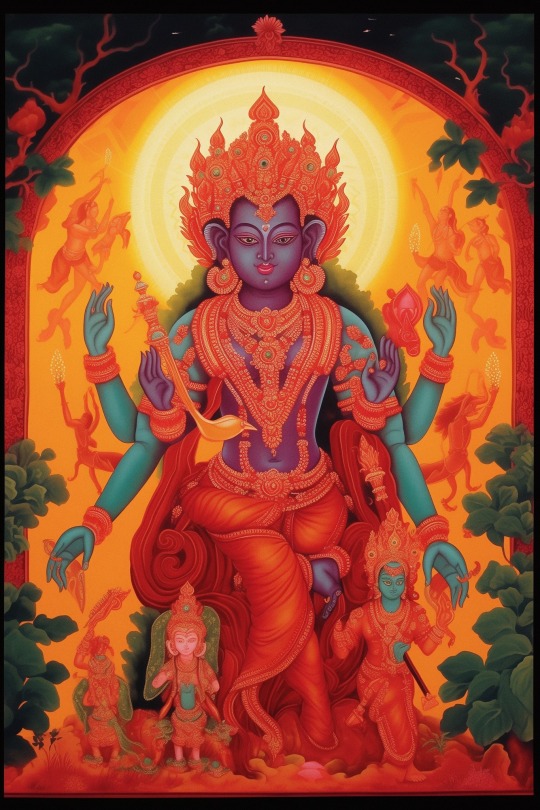
Madana Gopala “God of Love” Talon Abraxas
The form of Krishna known as Madanagopala is to be found in the sculptural programme of several Vaishnava temples of the Vijayayanagara era (fourteenth to eighteenth century) in southern India and, in particular, Tamil Nadu.
Madana is sweet enchantment, the seducer of the mind, and Gopala is the youthful herder of cows. In this form, Krishna has absorbed and subsumed the qualities of the god of love and sexual passion, Manmatha or Kama. The heats of lust and infatuation have been transformed into the rich rasa of transcendental love. Madanagopala sweetly sings and plays His flute, calling all to approach this exalted disposition – entering His world of luscious, enlightened duality where manifest form is the scintillating vibration of His eternal love play.
Madanagopala may be ten- or eight-armed and is depicted standing or seated upon a hexagon. As well as His flute, He carries various implements. Starting at the deity’s top right is the solar discus or chakra, the elephant goad/hook (ankusa) and then the flower arrow. From the top left, he holds the sacred conch (sankha), the three corded noose (pasa), and the sugarcane bow (ikshukodanda). The flower bow and arrow are both implements normally carried by Kama and his consort Rati, the goddess of pleasurable sensual enjoyment. Here, however, they are depicted as devotees of the Lord and they offer a garland of wild flowers from all seasons (vanamala). The single arrow held by Madanagopala is representative of Kama’s five powerful arrows of desire, each arrow representing a unique aspect of passion: excitement (unmadana), heat (tapana), drying up (sosana), paralyzing of normal bodily functions (stambhana) and full infatuation (sammohana).
The god of sensual love, Kama, is known by various epithets – Manmatha, Kandarpa, Madana, and Mara. Here He is shown on Krishna’s right. He holds aloft his standard – the makara banner from which Kama gets the additional name of Makaradhvaja, meaning that his flag is marked with the makara. It is symbolic of potent creation and fertility. Kama’s skin colour (nupura) is red, though variant forms are green or golden yellow. His father is Vishnu. The most famous mythological episode involving Kama is his having been burnt to ashes by Siva, whose meditation Kama had sought to disturb. Kama went on to be reborn as Krishna’s son, Pradyumna. He has two consorts, Priti (delight) and Rati (pleasure).
Rati is depicted on Madanagopala’s left. She is the daughter of Daksa Prajapati and her presence is likened to the youthful unfoldment of Vasant (spring) and with it, the longing in all nature for procreation. She is exceedingly attractive and well versed in seductive arts. Her hair is piled up into an elaborate ornamental knot (kesabandha), secured with a golden band decorated with fresh spring leaves and flowers. These impressive south Indian coiffures are to be seen on the figures of queens, princesses and high-ranking temple patrons.
As a pair, Kama and Rati are carved on pillars leading to the garbha griha. Their animal vehicles (vahanas), the goose, swan or parrot, are interchangeable. Lovely forms can be seen in the 17th century marriage hall (kalyana mandapa) in Kanchipuram’s Varadaraja temple. Outstanding even in the superlative world of Vijayanagara sculptural art are the splendid examples in Sri Villiputtar’s Andal temple complex. Here Rati sits astride a goose, admiring her own reflection in a mirror held aloft in her left hand, while the right holds a kohl stick.
Seated in the center at the bottom of the painting is Vishnu’s chief vahana, Garuda. He is shown as per his description in the Vishnu-dharmottara, with a body the color of an emerald, fierce bulging eyes and an eagle beak. There are many variant forms of Garuda – in North India one does not tend to see Garuda associated with Krishna, however, in the south, it is more frequent. In Vaishnava temples, Garuda is installed in a small shrine facing the garba griha (home of the main deity), or on a high pillar within the temple compound, or just outside the main entrance, as in Puri’s celebrated Jagganath temple.
Forming a canopy over Madanagopala’s head is the lush foliage of a Kalpakataru or wish-fulfilling tree. The tree boasts many types of flowers and fruits and is perpetually in bloom. It is a feature of the god’s celestial realms. Nestled within its foliage are several kili (parrots) and a mayil (peacock). Krishna cherishes both types of bird and is said to have several as pets. Midway to Madanagopala’s right is his favorite tree, the kadamba. It bears small, globular orange/yellow flowers with a beautiful perfume. In season, the flowers are much favoured for use as garlands. Growing at the Lord’s feet are a profusion of flowering sacred tulasi, a plant considered an incarnated goddess. Tulasi leaves are used as offerings to all Vaishnava deities and its wood is favoured for use in malas for mantra sadhana.
The two brown decorative panels at the sides of the arch display kinnaras. The term kinnara translates as something like ‘what are these?’ as they are a bizarre and beautiful com-posite of various creatures, animal, human and divine. They are usually shown playing musical instruments – especially, the veena. Kinnaras have intoxicating siren-like voices, but are aus-picious in nature and loving by disposition. They are often carved in light relief on temple pillars.
Lastly, within the orange border are two decorated friezes of the Vaishnava sectarian marking or Namam. The Namam is worn on the forehead and is typically of two forms (of course, there are variants). The form depicted on the upper strip is the Vadagalai which is U-shaped. The one on the lower strip is the Tengalai which is Y or V shaped. The central stripe between the U or V is known as the Tiruchurnam and is traditionally made of a lime and saffron mix or red ocher. The meaning of the Tiruchurnam is the same as that of the bindu: the whole-ness of divinity and the point of utmost potency from which all manifests. The wearing of the Namam is a highly important preparation for all kinds of ritual action or worship within the Vaishnava fold and is considered to be sanctifying for both the wearer and observer.
22 notes
·
View notes
Text
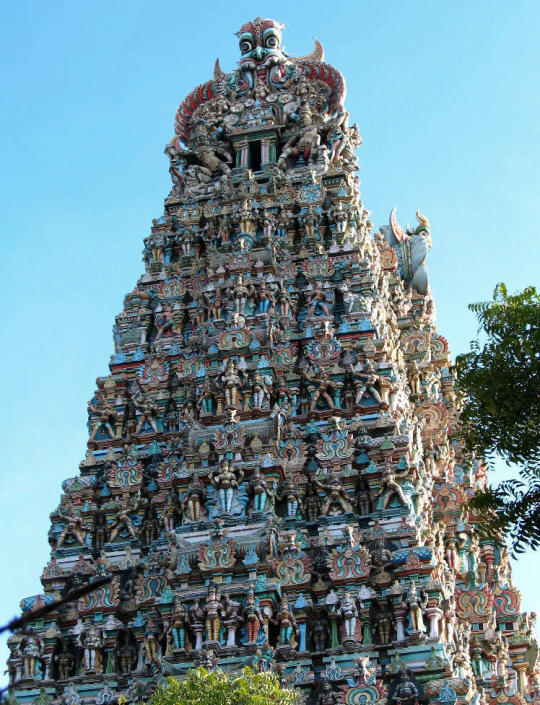
MWW Artwork of the Day (4/20/24) Late Medieval India (Vijayanagara Empire, 1336-1646) Gopuram, Minakshi Temple (1623-55) Madurai, Tamil Nadu, India
A gopuram is usually rectangular in form with ground-level wooden doors, often richly decorated, providing access. Above is the tapering gopuram, divided into many stories which diminish in size as the gopuram tower narrows. Usually the tower is topped with a barrel vaulted roof with a finial. Gopurams are exquisitely decorated with sculpture and carvings and painted with a variety of themes derived from the Hindu mythology, particularly those associated with the presiding deity of the temple where the gopuram is located.
12 notes
·
View notes
Text
Nappinnai in Ponniyin Selvan

Krishna-Nappinnai cult was prominent in Tamil-speaking areas of South India in the seventh to tenth centuries. Nappinnai can be considered a mix of Satya of Ashtabharya and Radha. This cult is the prototype of the later Radha-Krishna cult in the North. She features prominently in the poetry of Alwars (Vaishnavite poet saints) as the worldly wife of Krishna as different from the divine consorts of Lord Vishnu.
In Tamil poetry, Nappinnai is the daughter of Yashoda’s brother Kumbakan. She grew up with Krishna and Balarama and Krishna marries her by taming seven bulls in a public tournament. Nappinnai is featured in non-Hindu sources too. For example, in Jivaka Chintamani composed by the Jain saint Tirutakkatevar, a King is told that he shouldn't hesitate to marry a lower class woman because Tirumal himself is married to cowherdess Nappinnai.
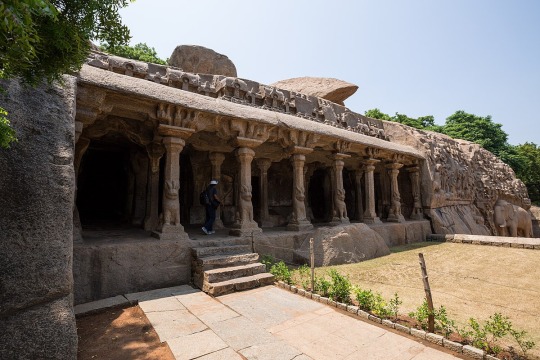
Krishna Mandapam at Mahabalipuram
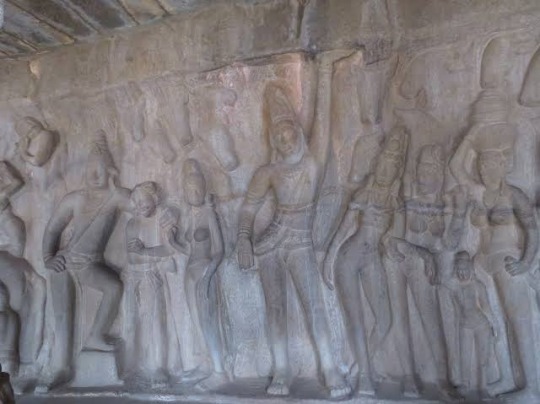
Krishnan lifting Govardhana, Balarama on the right side, consoling an old couple. Nappinnai on the left side gazing at him admiringly, holding the hands of his sister Subhadra.
Aditha Karikalan, Thirukkoilur Malayaman and Parthibendra Pallavan spend their night in this complex near the iconic Shore Temple, at the end of Book 1. The young princes discuss about sculptures and poetry, which Parthibendran finds distasteful. Malayaman leaves them to watch villu pattu in the Pancha ratha complex and it is here that Karikalan narrates the story of his heartbreak. Now it is a closed structure, but originally it was an open air bas relief. The mandapam enclosing it was constructed only in the 16th century, during Vijayanagara period.
An entire chapter (Achchiyar Kuravai) of Silappathikaram is about Nappinnai playing Kuravai dance with Krishan and Balaraman. Manimekalai (Sangham epic, not PS character) too mentions this dance. When Vanthiyathevan gives Aditha Karikalan's letter to Kundavai, Kundavai's retinue is seen dancing to this, singing about various asuras trying to kill Krishnan.
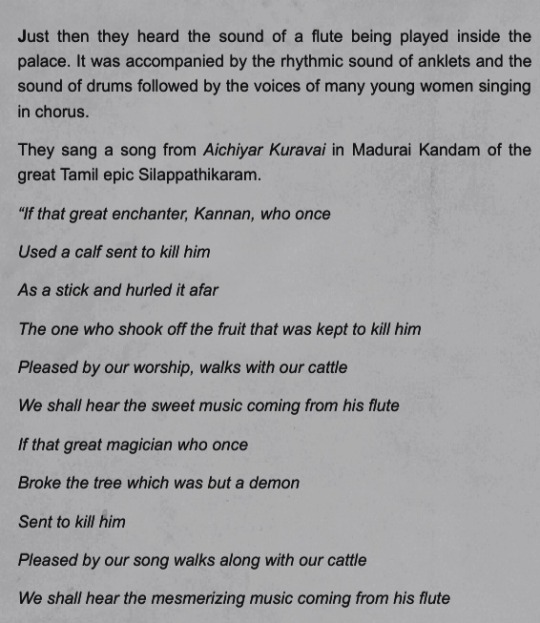
When Karikalan goes to Kadambur, there too we see the preparations for the Kuravai.
While having a heart to heart conversation (as much as someone like Nandini can open her heart), Nandini tells Manimegalai about her hallucinations. According to her, when we love or hate someone intensely, we can see and feel them even in their absence.
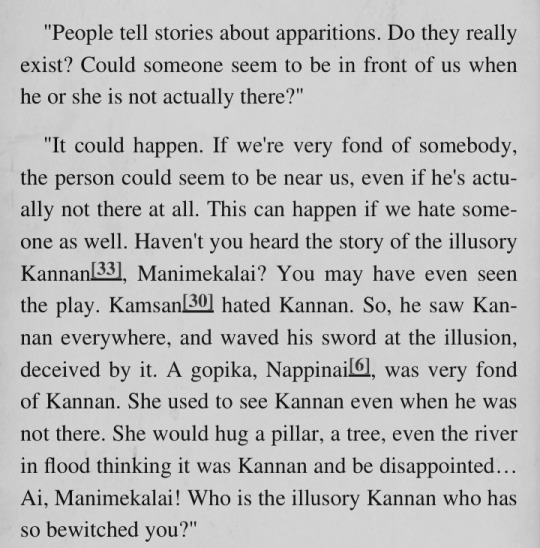
This is something Nandini made up for her consolation, because Nappinnai is never seperated from Krishna. In fact, it said that Vishnu left his divine wives and descended from his seat to be Nappinnai's beloved.
You parted from the eternal Great Flower [Lakshmi] and from the Lady Earth, became a youth, and then united in marriage with the shoulders of the cowherd Pinnai.
In Kuravai Koothu, women sing that Krishna avoids Lakshmi because he is so enamored by Nappinnai.
Is Pinnai of bangled arms so beautiful that He who had won great reputation by measuring the universe, would not look at Lakshmi dwelling in his own breast ?
It is to this Nappinnai that Andal prays to give her an opportunity to get one with Krishna, as her other attempts to wake him up were futile.


Nandini must have heard of the North Indian narratives about viraha unmadini (driven mad by seperation) Radha which were in their infancy then. Nappinnai didn't have the habit of seeing hallucinations - it is Nandini who has mental health issues.
This connection also shows Nandini's guilt about her life's circumstances though they were beyond her control. When Vanthiyathevan tells her that her Krishnan is still waiting for her, she replies that she doesn't deserve it. After marrying Periya Pazhuvettaraiyar, Nandini is never shown praying earnestly - either she is lying about different prayers and austerities or she is using devotion to avoid questions.
Edit: After writing the original post, I thought I will read Thirumangai Alwar's poems because his poetry is specifically mentioned in the chapter which shows Karikalan, Parthibendran and Malayaman going to the port to oversee the loading for goods for Arulmozhi's army. Look what I found:
Pinnai's forehead is a gleaming crescent moon So long ago in battle he subdued seven bulls for her hand And now he owns beautiful Kanchi which is surrounded by beautiful cool ponds of waters Where the sovereign of Pallavas who have the sharp blood stained sword in his hands Who owns a drum with a bitter mouth And the Conch with the roar of the sea Pays his obeisance to his Lord.
(The poem says that the poet's god is the Lord of Kanchi who is worshipped by the Pallava King. The rest are the descriptions of the the god and the king. In PS, crown prince Karikalan is ruling from Kanchi with Parthipendra Pallavan as his vasal)
Very subtle 🤣🤣
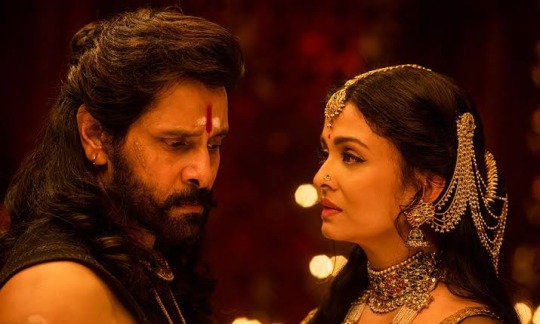
Are you even real, Maya Kanna?
@willkatfanfromasia @sowlspace @vibishalakshman @harinishivaa @thelekhikawrites @hollogramhallucination @thegleamingmoon @whippersnappersbookworm @nspwriteups @jukti-torko-golpo @arachneofthoughts @thirst4light
#ponniyin selvan#ponniyin selvan 2#aditha karikalan#nandini#nandhini#nandini x karikalan#kollywood#ps2#ps1
55 notes
·
View notes
Text

Ancient Hindu
Shree Krishna Sculpture at Chinatala
Venkatramana Temple, Tamil Hymns
from, "Naalayira Diwya Prabandham"
This is at Chinthala Venkata Ramana
Temple Tadipatri Ananthapur District
Andhra Pradesh.1510-1525 C.E, Built
by Timmanaidu the son of Rama ling
Naidu Chieftain Vijayanagara Empire
seen carved at base of Temple, Pillar
4 notes
·
View notes
Note
Some book recs for you!
Treacle Walker, Alan Garner (short, delightful, mystical fantasy)
Slow Horses, Mick Herron (+ series. Just in case you might want to read some extremely funny spy novels that drag right-wing nonsense constantly. With a lot of swearing and good female characters. Did I mention they're also very funny and well-written?)
A God in Every Stone, Kamila Shamsie (this one is for ugly-crying about history and narrative and how love will save us all)
Victory City, Salman Rushdie (I feel as though I have bothered you about this epic feminist romp through an alternative version of the Vijayanagara Empire already. I will continue to do so)
The House of Doors, Tan Twan Eng (also about history and narrative and desire, surprise surprise)
I read Victory City when it first came out (I think Midnight's Children is still my favorite Rushdie, but is it not everyone's?) and yes, I absolutely agree.
Just read House of Doors, not least because I had seen you recommend it before, and truly the whole time I was thinking, "yes, I see exactly why my dear friend and beloved mutual Oldshrewsburyian J. Internet is so into this." His prose is truly so effortless; how?!
Must read Slow Horses, for reasons. Also A God in Every Stone sounds as if it will emotionally devastate me, but I am here for it.
8 notes
·
View notes
Text
youtube
#politics#history#ancient history#indian history#indian economy#india#Vijayanagar empire#history of vijayanagar empire#vijayanagar empire history#hampi#karnataka#vijayanagara empire#the fall of vijayanagar empire#ancient india economy#indian economy in ancient time#pre independece indian economy#colonial era economy#indian economic past#economy#economic downfall#vijaynagara empire#Hampi#economics#India#poverty#governance#economic development#social issues#Empire Diaries On Road#trade deficit of india
0 notes
Text
Do you want to make An imperial capital Vijayanagara question answer notes for your class 12 history board exam? Memorysclub provides NCERT solutions for class 12 history chapter 7 An imperial capital Vijayanagara. Our teachers write Chapter 7 history class 12 exam-oriented practice questions for your upcoming exam. Click now to get solutions.
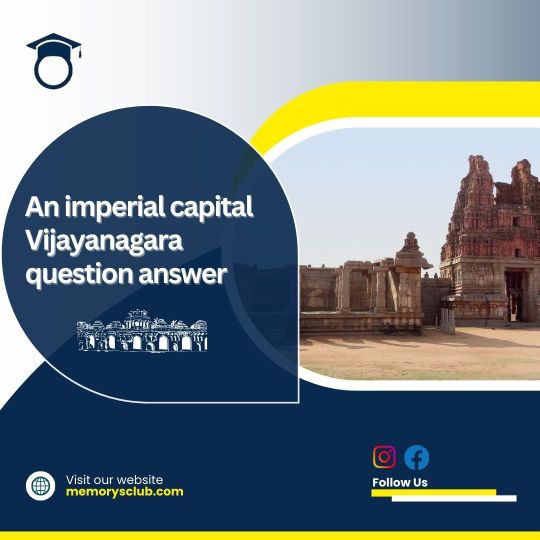
#an imperial capital Vijayanagara question answer#chapter 7 history class 12#an imperial capital Vijayanagara
0 notes
Text





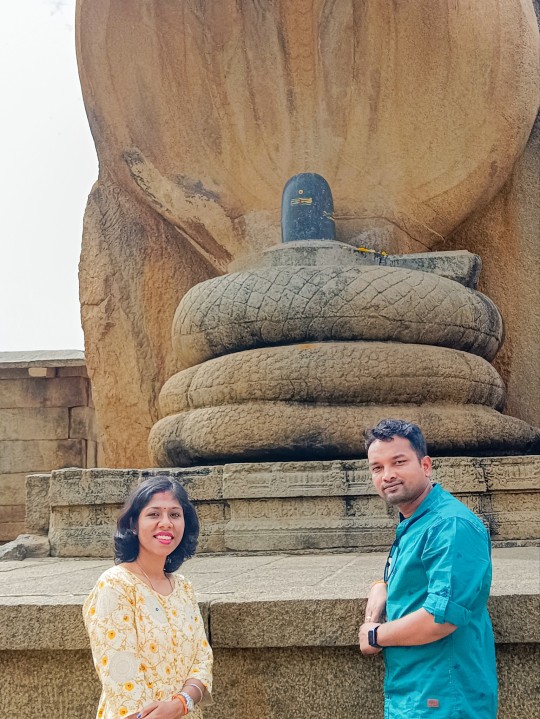




Lepakshi Temple: A 16th-century Vijayanagara-era temple in Andhra Pradesh, India, famous for its intricate carvings, stunning architecture, and mysterious hanging pillar, which defies gravity and fascinates visitors. Dedicated to Lord Veerabhadra, a form of Shiva, this temple is a testament to India's rich cultural heritage and architectural excellence.
#lepakshi #andhrapradesh #lepakshitemple #anantapur #india #incredibleindia #anantapurcity #hindupur #travel
#photography#travel#travelphotography#photooftheday#travelgram#dekhboebarjogottake#nature#vacation#sudipsense#art#temple
2 notes
·
View notes